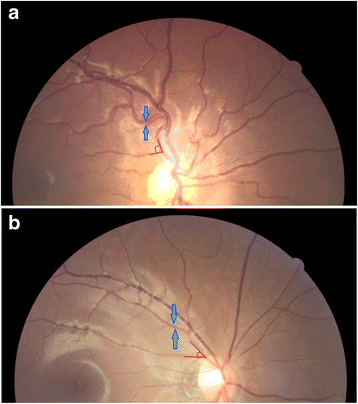Short-term poor glycemic control and retinal microvascular changes in pediatric Type 1 Diabetes patients in Singapore: a pilot study
- PMID: 28615013
- PMCID: PMC5471853
- DOI: 10.1186/s12886-017-0449-8
Short-term poor glycemic control and retinal microvascular changes in pediatric Type 1 Diabetes patients in Singapore: a pilot study
Abstract
Background: Poor glycemic control in Type 1 Diabetes (T1D) patients is strongly associated with an increased risk of diabetes-related microvascular complications later in life, but it is unclear whether short period of poor glycemic control in children with T1D can cause evident microvascular morphological changes long before any pathological manifestation. Our study aimed to investigate the longitudinal association between poor glycemic control and subsequent changes in retinal microvasculature, in a pilot study of 55 pediatric T1D patients from Singapore after a one-year follow-up.
Methods: This is a hospital-based, exposure-matched and retrospective longitudinal study. A total of 55 T1D patients were included from Singapore KK Women's and Children Hospital, 28 of whom had poor glycemic control (average glycated hemoglobin [HbA1c] ≥8% during the year) while the other 27 age- and gender-matched subjects had good glycemic control (HbA1c <8%). Retinal photography was taken at diabetes annual screening and images were graded by trained graders using a semi-automated computer-based program (Singapore I Vessel Assessment [SIVA], version 4.0, Singapore Eye Research Institute, Singapore) and a spectrum of retinal vascular parameters (e.g. caliber, tortuosity, branching angle and fractal dimension) were measured quantitatively from 0.5 to 2.0 disc diameters.
Results: There was no significant difference in ethnicity, duration of T1D, blood pressure, body mass index (BMI) and low-density cholesterol lipoprotein (LDL) between the two groups. Retinal imaging was obtained at the end of 1 year of glycemic control assessment. In multiple linear regression adjusting for ethnicity, BMI, LDL and duration of T1D, patients with poor glycemic control tended to have marginally wider retinal arteriolar caliber (6.0 μm, 95% CI: -0.9, 12.8) and had significantly larger retinal arteriolar branching angle (10.1 degrees, 95% CI: 1.4, 18.9) compared with their age- and gender- matched counterparts with good glycemic control.
Conclusions: Our findings showed that abnormal retinal microvascular morphology was evident in pediatric patients with T1D after one-year's poor glycemic control. Such morphological abnormalities may lead to future development of microvascular complications among T1D pediatric patients with poor glycemic control.
Keywords: Children; Glycemic control; Retinal microvascular changes; Type 1 Diabetes (T1D).
Figures

Similar articles
-
Early risk stratification in pediatric type 1 diabetes.Acta Ophthalmol. 2015 Mar;93 Thesis 1:1-19. doi: 10.1111/aos.12702. Acta Ophthalmol. 2015. PMID: 25703648
-
Sex differences in retinal microvasculature through puberty in type 1 diabetes: are girls at greater risk of diabetic microvascular complications?Invest Ophthalmol Vis Sci. 2014 Dec 4;56(1):571-7. doi: 10.1167/iovs.14-15147. Invest Ophthalmol Vis Sci. 2014. PMID: 25477322
-
Extended-Zone Retinal Vascular Caliber and Risk of Diabetic Retinopathy in Adolescents with Type 1 Diabetes.Ophthalmol Retina. 2020 Dec;4(12):1151-1157. doi: 10.1016/j.oret.2020.05.009. Epub 2020 May 21. Ophthalmol Retina. 2020. PMID: 32446907
-
Effect of early glycemic control on HbA1c tracking and development of vascular complications after 5 years of childhood onset type 1 diabetes: Systematic review and meta-analysis.Pediatr Diabetes. 2019 Aug;20(5):494-509. doi: 10.1111/pedi.12850. Epub 2019 Apr 24. Pediatr Diabetes. 2019. PMID: 30932298 Free PMC article.
-
Impact of Probiotics on the Glycemic Control of Pediatric and Adolescent Individuals with Type 1 Diabetes: A Systematic Review and Meta-Analysis.Nutrients. 2024 Aug 9;16(16):2629. doi: 10.3390/nu16162629. Nutrients. 2024. PMID: 39203766 Free PMC article.
Cited by
-
Flash Continuous Home Glucose Monitoring to Improve Adherence to Self-Monitoring of Blood Glucose and Self-Efficacy in Adolescents With Type 1 Diabetes.Clin Diabetes. 2020 Apr;38(2):152-158. doi: 10.2337/cd19-0051. Clin Diabetes. 2020. PMID: 32327887 Free PMC article.
-
A Novel Method for the Measurement of Retinal Arteriolar Bifurcation.Ophthalmol Ther. 2024 Apr;13(4):917-933. doi: 10.1007/s40123-023-00881-z. Epub 2024 Jan 31. Ophthalmol Ther. 2024. PMID: 38294630 Free PMC article.
-
Systematic Review on Fractal Dimension of the Retinal Vasculature in Neurodegeneration and Stroke: Assessment of a Potential Biomarker.Front Neurosci. 2020 Jan 28;14:16. doi: 10.3389/fnins.2020.00016. eCollection 2020. Front Neurosci. 2020. PMID: 32116491 Free PMC article.
-
Automated Systems for Calculating Arteriovenous Ratio in Retinographies: A Scoping Review.Diagnostics (Basel). 2022 Nov 18;12(11):2865. doi: 10.3390/diagnostics12112865. Diagnostics (Basel). 2022. PMID: 36428925 Free PMC article.
-
Exploring the effect of hypertension on retinal microvasculature using deep learning on East Asian population.PLoS One. 2020 Mar 5;15(3):e0230111. doi: 10.1371/journal.pone.0230111. eCollection 2020. PLoS One. 2020. PMID: 32134976 Free PMC article.
References
-
- The effect of intensive treatment of diabetes on the development and progression of long-term complications in insulin-dependent diabetes mellitus. The Diabetes Control and Complications Trial Research Group. N Engl J Med. 1993;329(14):977–86. - PubMed
MeSH terms
Substances
LinkOut - more resources
Full Text Sources
Other Literature Sources
Medical

